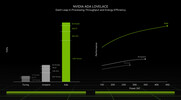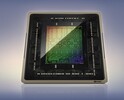Nvidia RTX 500 Ada Generation Laptop GPU vs Nvidia RTX 5000 Ada Generation Laptop GPU
Nvidia RTX 500 Ada Generation Laptop GPU
► remove from comparison
The Nvidia RTX 500 Ada Generation, not to be confused with the A500, P500 and the T500, is a lower-end professional graphics card for use in laptops that sports 2,048 CUDA cores and a paltry 4 GB of GDDR6 VRAM. We believe this graphics card to be a heavily cut-down GeForce RTX 4050 Laptop; therefore, both should employ the Ada Lovelace AD107 chip built with TSMC's 5 nm process. The RTX 500 was launched in February 2024. The Nvidia-recommended TGP range for this graphics card is moderately wide at 35 W to 60 W [the second figure includes the Dynamic Boost, it seems] leading to noticeable performance differences between different systems powered by what is supposed to be the same graphics card.
Quadro series graphics cards ship with much different BIOS and drivers than GeForce cards and are targeted at professional users rather than gamers. Commercial product design, large-scale calculations, simulation, data mining, 24 x 7 operation, certified drivers - if any of this sounds familiar, then a Quadro card will make you happy.
Architecture and Features
Ada Lovelace brings a range of improvements over older graphics cards utilizing the outgoing Ampere architecture. It's not just a better manufacturing process and a higher number of CUDA cores that we have here; under-the-hood refinements are plentiful, including an immensely larger L2 cache, an optimized ray tracing routine (a different way to determine what is transparent and what isn't is used), and other changes. Naturally, these graphics cards can both encode and decode some of the most widely used video codecs, AVC, HEVC and AV1 included; they also support a host of proprietary Nvidia technologies, including Optimus and DLSS 3, and they can certainly be used for various AI applications.
The RTX 500 Ada features 16 RT cores of the 3rd generation, 64 Tensor cores of the 4th generation and 2,048 CUDA cores. Increase those numbers by 25%, and you get the RTX 1000 Ada - as long as we pay no attention to clock speed differences, of course. Unlike costlier Ada Generation professional laptop graphics cards, the RTX 500 comes with just 4 GB of non-ECC VRAM; the lack of error correction makes this card less suitable for super-important tasks and round-the-clock operation. The VRAM is just 64-bit wide, delivering an anemic bandwidth of ~128 GB/s.
The RTX 500 Ada Generation makes use of the PCI-Express 4 protocol, just like Ampere-based cards did. 8K SUHD monitors are supported, however, DP 1.4a video outputs may prove to be a bottleneck down the line.
Performance
At 50 W (35 W + 15 W Dynamic Boost), the graphics card can handle most 2023 and 2024 games like Baldur's Gate 3 at 1080p on high graphics settings. With a Geekbench 6.2 OpenCL GPU score of 61,500 points and a Blender v3.3 Classroom CUDA score of 71 seconds, it's clear the Ada is so much faster than any integrated GPUs on the market including the 890M.
Power consumption
With the latest Nvidia graphics cards, laptop makers are free to set the TGP according to their needs within a fairly wide range. With the RTX 500 Ada, we have the lowest value recommended sitting at just at 35 W while the highest value is 60 W [this most likely includes Dynamic Boost]. Real-world performance of the slowest RTX 500 Ada will probably be around 40% lower than that of the fastest one.
Last but not the least, the improved 5 nm process (TSMC 4N) the AD107 chip is built with makes for decent energy efficiency, as of early 2024.
Nvidia RTX 5000 Ada Generation Laptop GPU
► remove from comparison
The Nvidia RTX 5000 Ada Generation, not to be confused with the A5000, P5000 and the RTX 5000 Turing Generation, is a super-powerful professional graphics card for use in laptops that sports 9,728 CUDA cores and 16 GB of ECC GDDR6 VRAM. Brought into existence in 2023, this graphics adapter leverages TSMC's 5 nm process and Nvidia's Ada Lovelace architecture to achieve great performance combined with reasonable power consumption. The Nvidia-recommended TGP range for the card is very wide at 80 W to 175 W leading to bizarre performance differences between different systems powered by what is supposed to be the same product.
Hardware-wise, the RTX 5000 is a GeForce RTX 4090 Laptop in disguise. Consequently, both make use of the AD103 chip and have little difficulty running triple-A games at UHD 2160p.
Quadro series graphics cards ship with much different BIOS and drivers than GeForce cards and are targeted at professional users rather than gamers. Commercial product design, large-scale calculations, simulation, data mining, 24 x 7 operation - if any of this sounds familiar, then a Quadro card will make you happy.
Architecture and Features
Ada Lovelace brings a range of improvements over older graphics cards utilizing the outgoing Ampere architecture. It's not just a better manufacturing process and a higher number of CUDA cores that we have here (up to 16,384 versus 10,752); under-the-hood refinements are plentiful, including an immensely larger L2 cache and an optimized ray tracing routine (a different way to determine what is transparent and what isn't is used) and other changes. Naturally, these graphics cards can both encode and decode some of the most widely used video codecs, AVC, HEVC and AV1 included; they also support a host of proprietary Nvidia technologies, including Optimus and DLSS 3, and they can certainly be used for various AI tasks.
The RTX 5000 features 76 RT cores of the 3rd generation, 304 Tensor cores of the 4th generation and 9,728 CUDA cores, making it a lot faster than the RTX 4000 Ada Generation. Elsewhere, the graphics card comes with 16 GB of 256-bit wide ECC GDDR6 memory for an impressive throughput of ~576 GB/s. Error correction can be turned off if desired. The fact that error correction is present here proves that the RTX 5000 is indeed targeted at professional users.
Just like Ampere-based cards, the RTX 5000 makes use of the PCI-Express 4 protocol. 8K SUHD monitors are supported, however DP 1.4a video outputs can potentially prove to be a bottleneck down the line.
Performance
The average RTX 5000 Ada Generation in our extensive database is noticeably inferior to the GeForce RTX 4080 in some tests but is totally comparable to the GeForce RTX 4090 in other ones, such as the Geekbench 6.2 GPU Vulkan test.
Nvidia's marketing materials mention "up to 42.6 TFLOPS" of performance which is very impressive. The RTX 4000 Ada Generation delivers up to 33.5 TFLOPS, for reference, while the RTX 500 Ada is only good for 9 TFLOPS.
Your mileage may vary depending on how competent the cooling solution of your laptop is and how high the TGP power target of the RTX 5000 is. One other thing worth mentioning is that enabling error correction appears to reduce the amount of video memory that is available to applications and games by up to a gigabyte.
Power consumption
Nvidia no longer divides its laptop graphics cards into Max-Q and non-max-Q models. Instead, laptop makers are free to set the TGP according to their needs, and the range can sometimes be shockingly wide. This is the case with the RTX 5000 Ada, as the lowest value recommended for it sits at just 80 W while the highest is more than two times higher at 175 W (this most likely includes Dynamic Boost). The slowest system built around an RTX 5000 Ada can easily be 60% slower than the fastest one. This is the kind of delta that we've already seen on consumer-grade laptops featuring the latest GeForce RTX cards.
Last but not the least, the improved 5 nm process (TSMC 4N) the RTX 5000 is built with makes for very decent energy efficiency, as of mid 2023.
| Nvidia RTX 500 Ada Generation Laptop GPU | Nvidia RTX 5000 Ada Generation Laptop GPU | |||||||||||||||||||||||||||||||||||||||||||
| RTX Ada Generation Laptop GPU Series |
|
| ||||||||||||||||||||||||||||||||||||||||||
| Architecture | Ada Lovelace | Ada Lovelace | ||||||||||||||||||||||||||||||||||||||||||
| Pipelines | 2048 - unified | 9728 - unified | ||||||||||||||||||||||||||||||||||||||||||
| TMUs | 64 | 304 | ||||||||||||||||||||||||||||||||||||||||||
| ROPs | 32 | 112 | ||||||||||||||||||||||||||||||||||||||||||
| Raytracing Cores | 16 | 76 | ||||||||||||||||||||||||||||||||||||||||||
| Tensor / AI Cores | 64 | 304 | ||||||||||||||||||||||||||||||||||||||||||
| Memory Speed | 12000 effective = 1500 MHz | 20000 effective = 2250 MHz | ||||||||||||||||||||||||||||||||||||||||||
| Memory Bus Width | 64 Bit | 256 Bit | ||||||||||||||||||||||||||||||||||||||||||
| Memory Type | GDDR6 | GDDR6 | ||||||||||||||||||||||||||||||||||||||||||
| Max. Amount of Memory | 4 GB | 16 GB | ||||||||||||||||||||||||||||||||||||||||||
| Shared Memory | no | no | ||||||||||||||||||||||||||||||||||||||||||
| Memory Bandwidth | 128 GB/s | 576 GB/s | ||||||||||||||||||||||||||||||||||||||||||
| API | DirectX 12 Ultimate, Shader 6.7, OpenGL 4.6, OpenCL 3.0, Vulkan 1.3 | DirectX 12 Ultimate, Shader 6.7, OpenGL 4.6, OpenCL 3.0, Vulkan 1.3 | ||||||||||||||||||||||||||||||||||||||||||
| Power Consumption | 60 Watt (35 - 60 Watt TGP) | 150 Watt (80 - 150 Watt TGP) | ||||||||||||||||||||||||||||||||||||||||||
| technology | 5 nm | 4 nm | ||||||||||||||||||||||||||||||||||||||||||
| PCIe | 4.0 x16 | 4 x16/x8 | ||||||||||||||||||||||||||||||||||||||||||
| Displays | 4 Displays (max.), HDMI 2.1, DisplayPort 1.4a | 4 Displays (max.), HDMI 2.1, DisplayPort 1.4a | ||||||||||||||||||||||||||||||||||||||||||
| Notebook Size | medium sized | large | ||||||||||||||||||||||||||||||||||||||||||
| Date of Announcement | 27.02.2024 | 21.03.2023 | ||||||||||||||||||||||||||||||||||||||||||
| Link to Manufacturer Page | images.nvidia.com | images.nvidia.com | ||||||||||||||||||||||||||||||||||||||||||
| Core Speed | 930 - 1680 (Boost) MHz | |||||||||||||||||||||||||||||||||||||||||||
| Cache | L2: 64 MB | |||||||||||||||||||||||||||||||||||||||||||
| Transistors | 76.3 Billion | |||||||||||||||||||||||||||||||||||||||||||
| Predecessor | RTX A5500 Laptop GPU |
Benchmarks
3DM Vant. Perf. total + Nvidia RTX 500 Ada Generation Laptop GPU
specvp12 sw-03 + Nvidia RTX 5000 Ada Generation Laptop GPU
Cinebench R15 OpenGL 64 Bit + Nvidia RTX 500 Ada Generation Laptop GPU
Average Benchmarks Nvidia RTX 500 Ada Generation Laptop GPU → 100% n=31
Average Benchmarks Nvidia RTX 5000 Ada Generation Laptop GPU → 457% n=31
* Smaller numbers mean a higher performance
1 This benchmark is not used for the average calculation
Game Benchmarks
The following benchmarks stem from our benchmarks of review laptops. The performance depends on the used graphics memory, clock rate, processor, system settings, drivers, and operating systems. So the results don't have to be representative for all laptops with this GPU. For detailed information on the benchmark results, click on the fps number.

F1 24
2024
Ghost of Tsushima
2024
Total War Pharaoh
2023
Baldur's Gate 3
2023
F1 23
2023
Returnal
2023
F1 22
2022
Cyberpunk 2077 1.6
2022
Far Cry 6
2021
Far Cry 5
2018
X-Plane 11.11
2018
Dota 2 Reborn
2015
The Witcher 3
2015
GTA V
2015Average Gaming Nvidia RTX 500 Ada Generation Laptop GPU → 100%
Average Gaming 30-70 fps → 100%
Average Gaming Nvidia RTX 5000 Ada Generation Laptop GPU → 220%
Average Gaming 30-70 fps → 322%
| Nvidia RTX 500 Ada Generation Laptop GPU | Nvidia RTX 5000 Ada Generation Laptop GPU | |||||||||||||
|---|---|---|---|---|---|---|---|---|---|---|---|---|---|---|
| low | med. | high | ultra | QHD | 4K | low | med. | high | ultra | QHD | 4K | |||
| F1 24 | 112.9 | 80.8 | 26.5 | 16 | 22 | |||||||||
| Ghost of Tsushima | 56.4 | 47.1 | 40.2 | 30.9 | 22 | |||||||||
| Avatar Frontiers of Pandora | 42 | 38 | 32 | 20 | ||||||||||
| Call of Duty Modern Warfare 3 2023 | 88 | 78 | 58 | 49 | 33 | |||||||||
| Total War Pharaoh | 199 | 129 | 73 | 56 | 39 | |||||||||
| Assassin's Creed Mirage | 78 | 69 | 55 | 40 | 32 | |||||||||
| Cyberpunk 2077 2.2 Phantom Liberty | 52.9 | 37.7 | 25.4 | 25 | 19.8 | 125 | 116.6 | 94.6 | 108.5 | 63.7 | 28.8 | |||
| Baldur's Gate 3 | 69.4 | 53.6 | 39 | 38.9 | 26.8 | 172.3 | 155.2 | 139.2 | 134.6 | 100.5 | 53.3 | |||
| F1 23 | 136.5 | 119.8 | 84.1 | 25 | 16 | |||||||||
| F1 22 | 150.4 | 134.4 | 99.6 | 32.9 | 236 | 229 | 210 | 87 | 60 | 31 | ||||
| Far Cry 6 | 126 | 80 | 68 | |||||||||||
| Strange Brigade | 316 | 126 | 104 | 91 | 63 | 408 | 326 | 291 | 268 | 203 | 105 | |||
| Far Cry 5 | 135 | 86 | 78 | 74 | 50 | 149 | 137 | 131 | 127 | 119 | 71 | |||
| X-Plane 11.11 | 128.3 | 103.5 | 81.5 | 155 | 134 | 105 | 88 | |||||||
| Final Fantasy XV Benchmark | 130.5 | 71 | 50 | 36.1 | 197 | 170 | 136 | 108 | 64 | |||||
| Dota 2 Reborn | 176.2 | 156.1 | 148.1 | 137.4 | 186 | 168 | 164 | 150 | 143 | |||||
| The Witcher 3 | 278 | 175 | 91 | 51 | 36 | 445 | 370 | 271 | 144 | 102 | ||||
| GTA V | 182.7 | 177.4 | 138.2 | 64.6 | 45.1 | 185.4 | 179.7 | 175.3 | 117.1 | 106.6 | 108 | |||
| Nvidia RTX 500 Ada Generation Laptop GPU | Nvidia RTX 5000 Ada Generation Laptop GPU | |||||||||||||
| low | med. | high | ultra | QHD | 4K | low | med. | high | ultra | QHD | 4K | < 30 fps < 60 fps < 120 fps ≥ 120 fps | 3 4 11 | 4 8 6 | 2 6 8 2 | 4 7 3 1 | 5 7 1 | | < 30 fps < 60 fps < 120 fps ≥ 120 fps | 10 | 1 9 | 2 8 | 3 5 | 6 1 | 1 2 6 1 |
For more games that might be playable and a list of all games and graphics cards visit our Gaming List



















